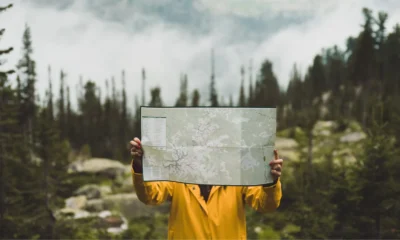SEO
12 Actions That Help Improve Your Google Keyword Rankings

Right now, someone is doing a Google search to find a new product, service, or solution to their problem, something that your business is uniquely qualified to provide.
Will they end up on your website where they’ll see how you have exactly what they’re looking for?
If your website doesn’t show up on the first page of Google results, the answer is, unfortunately, probably not. That’s for a few reasons.
Firstly, Google dominates the search engine market, with more than 85% of global traffic and 270 million unique visitors in the U.S. alone.
Secondly, 75% of internet users never go beyond the first page of results.
Now consider that 34.36% of all clicks go to the number one search result, and it becomes clear why search engine optimization (SEO) is so important.
But, you already knew that – it’s why you’re reading this article, after all.
You probably also realize that SEO is a marathon, not a sprint.
In Google’s unending quest to provide better results to searchers’ queries, its algorithm is updated thousands of times every year.
And while some of these are so minor most people will never notice them, Google occasionally rolls out an update that significantly impacts search engine results pages (SERPs).
What’s an SEO professional to do?
In the past, the answer was to jam keywords everywhere on your site, with the idea that more is better. Those days are gone.
Google’s algorithm has increased in complexity, which means it is now better able to understand the intent behind queries.
And, this means it values sites that provide better answers to those searches over those that are just packed with relevant words and phrases.
To ensure your website ranks highly, you can’t just focus on what search engines are looking for.
You also need to consider the experiences of visitors to your site. You need to take a holistic view of the value your website provides to users, then optimize your content so that it gets the results you need.
Let’s take a closer look at various ranking factors and discuss how you can more effectively use keywords to drive search traffic.
1. Measure Your Rankings
The first (and probably the most obvious) place to start is measuring your rankings.
Without a solid understanding of your baseline keyword performance, you won’t know how far you’ve come and how much you’ve improved.
I’d highly suggest exporting all of this valuable keyword data and keeping it on file for future reference. If nothing else, it will show you how much better you’ve gotten at SEO.
Some of us may have learned the hard way, but you never know when things will change with any given tool – whether it’s how data is reported, what information we have access to, etc.

Export keyword data from Google Search Console and landing page traffic (organic and total) from Google Analytics.
Analyzing this data will give you a good idea of:
- Your most valuable keywords/landing pages.
- The most immediate opportunities for improvement.
- Keywords/landing pages that are underperforming.
Focus on improving keywords that are ranking in positions five through 15 (where you’re teetering at the bottom of Page 1 or top of Page 2 on Google).
It’s easier to get these terms ranked at the top of the first page on Google, which will give you some quick wins to share with your client or boss.
2. Target The Right Keywords
To ensure your keyword targets are aligned with overarching business objectives and offer real value, it’s important that you understand both the search intent behind them and the difficulty of ranking.
While terms have a particular meaning to you, they could take on an entirely different meaning in Google and vice versa.
Knowing the intent, whether it’s informational/educational, transactional, or navigational, will help you understand which stage of the sales funnel users are at.
Doing a thorough SERP analysis is essential. Look at what’s currently ranking in the top search result for your core keyword targets including:
 Screenshot from search for [search intent], Google, May 2022
Screenshot from search for [search intent], Google, May 2022
Knowing what is required to rank for a particular keyword will help you draw conclusions about what content development efforts will be required, as well as come up with a plan for creation.
Semrush’s SEO Content Template is really great for this type of analysis.
You simply enter a keyword, and the tool will analyze what’s showing up in Google’s top results to provide recommendations for SEO-friendly content.
 Screenshot from Semrush, May 2022
Screenshot from Semrush, May 2022
Cross-referencing your organic keyword research with paid advertising data can also help uncover new opportunities and fill gaps.
Don’t ignore long-tail queries. While they may have lower search volume, you could be missing out on extremely targeted audiences that are ready to buy.
3. Clean Up Your Site Structure
The structure of your website plays a big role in SEO. Set a solid foundation for yours by resolving any technical issues that may diminish your organic keyword visibility.
Site pages should be both easily found and navigated by search engines and users.
If your website is difficult for users to navigate and search engines to crawl, your keyword rankings will likely be negatively impacted.
And, vice versa – if your website is intuitive for both users and Google, your rankings are bound to see positive increases.
Make sure that your site has a solid website structure, fix any broken links, and resolve any duplicate content issues.
Conducting a thorough technical SEO audit is necessary to ensure all priority technical issues are addressed.
4. Pay Attention To User Experience Signals
User experience and brand equity are important when it comes to driving organic search visibility.
While user experience may not be a direct responsibility of a search engine marketer, it’s important that user experience and SEO work together – especially considering that Google’s algorithm has consistently taken UX into page rankings
To ensure web visitors are interacting with your website, you should use Google’s Core Web Vitals report.
This monitors the loading time of each page on your site and generates data to show you which pages are providing good experiences and which need work.
Another important UX area you need to consider is the responsiveness of your site.
Mobile web browsing first surpassed desktop in 2017 and now accounts for more than 54% of global traffic.
If your website is not responsive, you will have a higher bounce rate, which in turn will negatively affect your ranking.
Here are some other elements that present an opportunity to improve UX and SEO:
- Keyword research: Confirm that you’re targeting keywords that have the right search intent and are aligned with the language that your target audiences use.
- Page tagging: Ensure page tagging is engaging and encourages clicks to your website (title tags, meta descriptions, and main headings).
- Content optimization: Keep users on the page and provide them with another logical destination or next step. This involves everything from the navigation to the copy, internal cross-linking, and calls-to-action on your site.
- Page speed: Give users the content they are requesting quickly and seamlessly across devices. Compress images, be mobile-friendly, clean up your code, and speed up your server.
5. Optimize For Users & Search Engines
Many of us get so fixated on optimizing content for Google that we forget what the end game is – to reach a highly targeted set of humans.
While search engines and humans have different ways of reading and digesting content, there are certain commonalities that will help ensure we are creating content with both in mind.
Both robots and humans want us to be:
- Be clear and concise.
- Provide accurate information.
- Avoid jargon.
- Cover-related subtopics.
This is important to keep in mind from the start of your content creation process.
As we are thinking about ways to make our content easier to read for both users and search engines, header tags are key.
Not only will proper header tags improve the overall readability of your content, but they will also ensure search engines can follow the hierarchy of what is most important on the page.
Images should also be a consideration, as providing more engaging imagery can make all the difference for users.
This also presents the opportunity to further optimize for search engines through ALT text and file naming.
6. Create Eye-Catching & Engaging Titles
Dare I say that title tags are the most important SEO element of a webpage?
Not just because it’s an SEO best practice, but also because it’s the first thing users see in search results and on social media.
The title tag is your biggest opportunity to catch the eyes of a user and encourage them to click into the page.
Determine the page that you want to rank for each keyword target, and then figure out a way for your title to stand out from all the others.
Yes, the keyword target should be included towards the beginning of the title tag, but how else can you encourage users to click?
BuzzSumo analyzed 100 million headlines and learned that:
- Emotional headlines drive interactions.
- Curiosity and voyeurism gain engagement.
- List posts and the number 10 in headlines are extremely powerful.
While meta descriptions don’t have a direct impact on rankings, they should work closely with your title tags. Incorporate the keyword if possible, as well as a clear call-to-action for users.
The goal of your title tag and meta description should be to explain the benefit to users, provoke emotion, and trigger engagement – all while applying SEO best practices.
7. Stay On Top Of Algorithm Updates
Why should you care about Google’s most recent algorithm updates?
Because good SEO professionals stay on top of that stuff.
Among many other reasons, it helps ensure your keyword rankings are not only steady, but they’re constantly improving.
Knowing when an algorithm update first hit and when it officially ended is useful for tracking purposes, and will allow you to trace keyword and traffic fluctuations back to the root cause.
This will help you uncover potential reasoning for how/why a site was hit by an update, or certain keyword rankings and pieces of content that may have been impacted by it.
When multiple algorithm updates happen over a short stretch of time, figuring out why certain site changes have occurred and analyzing the impact of a specific update is extremely difficult.
8. Provide Answers To The Questions People Are Asking
Google seeks to provide users with the best answers to their queries.
Just look at all of the new and increased SERP features we have seen over the past few years:
 Screenshot from search for [digital transformation], Google, May 2022
Screenshot from search for [digital transformation], Google, May 2022
Optimizing for featured snippet results and rich snippets around your priority keyword targets is now becoming an essential part of SEO strategy.
While there is certainly a great deal of debate over the direct value that ranking in “position zero” of search results offers a business, ultimately, I pose this question:
Would you rather have your competitor rank in the Answer Box for that search query?
As far as we know, the featured snippet result isn’t going away anytime soon, and not ranking in it could mean lost visibility to your competitor, or even your “frenemy” Google.
9. Build Valuable Inbound Links
Start by looking for opportunities on your website to cross-link to assets from keyword-rich anchor text. This will help drive users to relevant content and build keyword associations.
Unfortunately, crafting a strong internal link strategy is only half of the battle.
The other half is generating highly authoritative and valuable inbound links from third-party websites.
This can seem overwhelming, but there are some key tactics to hone in on:
- Create link-worthy content that is based on your keyword research and analysis of what is ranking in top search results to help generate inbound links and improve keyword rankings.
- Monitor mentions of your brand for some quick-win opportunities to gain an inbound link from websites that are already talking about you.
- If you want other websites to link to you, remember to link to other websites. You only get as much as you give.
- Leverage social media to support link building. Interact with your targets beforehand to help build relationships prior to reaching out about a link building opportunity.
These are just a few tactics to get you started. However, there are certainly more advanced link building tactics to be successful in today’s extremely competitive landscape.
10. Promote Your Content Strategically
I mention this briefly above, but it’s also important to leverage non-SEO channels in an effort to drive visibility to your assets and support your link building efforts.
The more eyes that you get on your content, the more opportunity you have to:
 Screenshot by author, May 2022
Screenshot by author, May 2022
While different promotional tactics may apply to different types of content, creating a checklist is always helpful.
This way, when it comes time to promote an asset, you have a list of all possible tactics.
This could include:
- Distributing across social media channels.
- Pushing out an email to subscribers.
- Encouraging shares from internal team members.
- Reaching out to those mentioned in the asset.
- Setting up Google Alerts to monitor conversations around the topic.
- Sharing directly with certain experts or influencers.
- Answering related questions on Quora or other forums.
- Advertising on social media.
- Identifying existing internal cross-link opportunities.
- Creating a SlideShare presentation or repurposing the asset in other forms.
11. Continuously Optimize & Improve Content
While there are numerous other factors that are important to SEO, content is still king.
Quality content counts more than anything else when Google is determining how well your site answers a query.
In fact, if you only take one thing away from this piece (and hopefully you’ll take more than that), it should be the importance of high-quality content. Emphasis on “high quality.”
Google’s Search Quality Guidelines explicitly state the importance of E-A-T, that is expertise, authoritativeness, and trustworthiness.
Your content should assert to both search engines and visitors that you are a reliable expert on the topics related to your keywords.
But because search engine results are constantly changing, you need to make continuous optimizations and improvements to your content.
For example, just because you’ve gained the Featured Snippet result for a particular keyword or phrase, does not mean that you will stay there.
Refreshing your content will ensure that you’re offering users the best (and most up-to-date) information and driving increased keyword visibility.
If the content is out of date, you will likely see the associated keyword rankings decline.
On the other hand, if you’re always looking for opportunities to refresh your content and provide users with the best material, you will likely see keyword ranking increases.
Content optimization should never be one-and-done, especially if you aren’t seeing the results that you want.
If an asset isn’t ranking, re-optimize it for relevance, search intent, engagement, and readability.
Your goal should be to offer users a piece of content that is better than everything else being displayed for the given query.
The concept, “If it’s not broken, don’t fix it.” certainly applies here.
For example, if you are ranking in the first position on Google for an extremely competitive and highly searched keyword, you don’t want to risk losing that.
In that case, I would not recommend changing the title tag or anything that could have a negative impact.
However, there could be opportunities to make the asset that is ranking more conversion-friendly and encourage users to stay on your site.
12. Setup & Optimize Your Google Business Profile
Local search has become another important part of SEO.
In addition to driving business to your physical location, it also has an impact on your website’s rankings.
In many cases, Google factors the searcher’s location into SERPs.
Things like photos, reviews, and phone numbers are more likely to include answers to queries than text-only links.
The best way to get in on local searches is to create and optimize your Google Business Profile.
This free service allows you to manage how your business shows up across Google properties, including Maps, Reviews, and Local Pack Listings.
A Google Business Profile improves your visibility and gives users information about you at a glance. It also allows people to review your business on Google.
Not only do these increase your credibility and allow you to control the narrative around your business, but they are also thought to have a significant impact on rankings.
Further, your profile will provide you with insights into your audience that may help you uncover new opportunities and keywords to target.
You get information on which queries are directing searchers to your website, how they are interacting with your posts and how many clicks your website link is generating.
Final Thoughts
An SEO professional’s work is never done.
And, even if Google someday decides, “You know what? We’ve finally got this algorithm perfect.” (which they never will), your results on SERPs will constantly change as others targeting the same keywords tweak and adjust their own strategies and content.
This means you need to keep working on your website. Just remember, SEO is a marathon, not a sprint.
Just because you don’t see the results you want right away doesn’t mean you’re not on the right track.
And vice versa – don’t assume because you’re highly ranked today that you’ll stay there.
SEO takes a lot of testing. Don’t be afraid to experiment.
You may not always get the top spot, but if you put in the work and follow these SEO best practices, you should see your site climb the rankings.
And that will bring with it the traffic you want.
More Resources:
Featured Image: Jirsak/Shutterstock
!function(f,b,e,v,n,t,s)
{if(f.fbq)return;n=f.fbq=function(){n.callMethod?
n.callMethod.apply(n,arguments):n.queue.push(arguments)};
if(!f._fbq)f._fbq=n;n.push=n;n.loaded=!0;n.version=’2.0′;
n.queue=[];t=b.createElement(e);t.async=!0;
t.src=v;s=b.getElementsByTagName(e)[0];
s.parentNode.insertBefore(t,s)}(window,document,’script’,
‘https://connect.facebook.net/en_US/fbevents.js’);
if( typeof sopp !== “undefined” && sopp === ‘yes’ ){
fbq(‘dataProcessingOptions’, [‘LDU’], 1, 1000);
}else{
fbq(‘dataProcessingOptions’, []);
}
fbq(‘init’, ‘1321385257908563’);
fbq(‘init’, ‘239948206198576’);
fbq(‘track’, ‘PageView’);
fbq(‘trackSingle’, ‘1321385257908563’, ‘ViewContent’, {
content_name: ‘how-to-improve-your-keyword-rankings-in-google’,
content_category: ‘strategy seo seo-strategy’
});
SEO
How To Write ChatGPT Prompts To Get The Best Results

ChatGPT is a game changer in the field of SEO. This powerful language model can generate human-like content, making it an invaluable tool for SEO professionals.
However, the prompts you provide largely determine the quality of the output.
To unlock the full potential of ChatGPT and create content that resonates with your audience and search engines, writing effective prompts is crucial.
In this comprehensive guide, we’ll explore the art of writing prompts for ChatGPT, covering everything from basic techniques to advanced strategies for layering prompts and generating high-quality, SEO-friendly content.
Writing Prompts For ChatGPT
What Is A ChatGPT Prompt?
A ChatGPT prompt is an instruction or discussion topic a user provides for the ChatGPT AI model to respond to.
The prompt can be a question, statement, or any other stimulus to spark creativity, reflection, or engagement.
Users can use the prompt to generate ideas, share their thoughts, or start a conversation.
ChatGPT prompts are designed to be open-ended and can be customized based on the user’s preferences and interests.
How To Write Prompts For ChatGPT
Start by giving ChatGPT a writing prompt, such as, “Write a short story about a person who discovers they have a superpower.”
ChatGPT will then generate a response based on your prompt. Depending on the prompt’s complexity and the level of detail you requested, the answer may be a few sentences or several paragraphs long.
Use the ChatGPT-generated response as a starting point for your writing. You can take the ideas and concepts presented in the answer and expand upon them, adding your own unique spin to the story.
If you want to generate additional ideas, try asking ChatGPT follow-up questions related to your original prompt.
For example, you could ask, “What challenges might the person face in exploring their newfound superpower?” Or, “How might the person’s relationships with others be affected by their superpower?”
Remember that ChatGPT’s answers are generated by artificial intelligence and may not always be perfect or exactly what you want.
However, they can still be a great source of inspiration and help you start writing.
Must-Have GPTs Assistant
I recommend installing the WebBrowser Assistant created by the OpenAI Team. This tool allows you to add relevant Bing results to your ChatGPT prompts.
This assistant adds the first web results to your ChatGPT prompts for more accurate and up-to-date conversations.
It is very easy to install in only two clicks. (Click on Start Chat.)
For example, if I ask, “Who is Vincent Terrasi?,” ChatGPT has no answer.
With WebBrower Assistant, the assistant creates a new prompt with the first Bing results, and now ChatGPT knows who Vincent Terrasi is.
 Screenshot from ChatGPT, March 2023
Screenshot from ChatGPT, March 2023You can test other GPT assistants available in the GPTs search engine if you want to use Google results.
Master Reverse Prompt Engineering
ChatGPT can be an excellent tool for reverse engineering prompts because it generates natural and engaging responses to any given input.
By analyzing the prompts generated by ChatGPT, it is possible to gain insight into the model’s underlying thought processes and decision-making strategies.
One key benefit of using ChatGPT to reverse engineer prompts is that the model is highly transparent in its decision-making.
This means that the reasoning and logic behind each response can be traced, making it easier to understand how the model arrives at its conclusions.
Once you’ve done this a few times for different types of content, you’ll gain insight into crafting more effective prompts.
Prepare Your ChatGPT For Generating Prompts
First, activate the reverse prompt engineering.
- Type the following prompt: “Enable Reverse Prompt Engineering? By Reverse Prompt Engineering I mean creating a prompt from a given text.”
 Screenshot from ChatGPT, March 2023
Screenshot from ChatGPT, March 2023ChatGPT is now ready to generate your prompt. You can test the product description in a new chatbot session and evaluate the generated prompt.
- Type: “Create a very technical reverse prompt engineering template for a product description about iPhone 11.”
 Screenshot from ChatGPT, March 2023
Screenshot from ChatGPT, March 2023The result is amazing. You can test with a full text that you want to reproduce. Here is an example of a prompt for selling a Kindle on Amazon.
- Type: “Reverse Prompt engineer the following {product), capture the writing style and the length of the text :
product =”
 Screenshot from ChatGPT, March 2023
Screenshot from ChatGPT, March 2023I tested it on an SEJ blog post. Enjoy the analysis – it is excellent.
- Type: “Reverse Prompt engineer the following {text}, capture the tone and writing style of the {text} to include in the prompt :
text = all text coming from https://www.searchenginejournal.com/google-bard-training-data/478941/”
 Screenshot from ChatGPT, March 2023
Screenshot from ChatGPT, March 2023But be careful not to use ChatGPT to generate your texts. It is just a personal assistant.
Go Deeper
Prompts and examples for SEO:
- Keyword research and content ideas prompt: “Provide a list of 20 long-tail keyword ideas related to ‘local SEO strategies’ along with brief content topic descriptions for each keyword.”
- Optimizing content for featured snippets prompt: “Write a 40-50 word paragraph optimized for the query ‘what is the featured snippet in Google search’ that could potentially earn the featured snippet.”
- Creating meta descriptions prompt: “Draft a compelling meta description for the following blog post title: ’10 Technical SEO Factors You Can’t Ignore in 2024′.”
Important Considerations:
- Always Fact-Check: While ChatGPT can be a helpful tool, it’s crucial to remember that it may generate inaccurate or fabricated information. Always verify any facts, statistics, or quotes generated by ChatGPT before incorporating them into your content.
- Maintain Control and Creativity: Use ChatGPT as a tool to assist your writing, not replace it. Don’t rely on it to do your thinking or create content from scratch. Your unique perspective and creativity are essential for producing high-quality, engaging content.
- Iteration is Key: Refine and revise the outputs generated by ChatGPT to ensure they align with your voice, style, and intended message.
Additional Prompts for Rewording and SEO:
– Rewrite this sentence to be more concise and impactful.
– Suggest alternative phrasing for this section to improve clarity.
– Identify opportunities to incorporate relevant internal and external links.
– Analyze the keyword density and suggest improvements for better SEO.
Remember, while ChatGPT can be a valuable tool, it’s essential to use it responsibly and maintain control over your content creation process.
Experiment And Refine Your Prompting Techniques
Writing effective prompts for ChatGPT is an essential skill for any SEO professional who wants to harness the power of AI-generated content.
Hopefully, the insights and examples shared in this article can inspire you and help guide you to crafting stronger prompts that yield high-quality content.
Remember to experiment with layering prompts, iterating on the output, and continually refining your prompting techniques.
This will help you stay ahead of the curve in the ever-changing world of SEO.
More resources:
Featured Image: Tapati Rinchumrus/Shutterstock
SEO
Measuring Content Impact Across The Customer Journey

Understanding the impact of your content at every touchpoint of the customer journey is essential – but that’s easier said than done. From attracting potential leads to nurturing them into loyal customers, there are many touchpoints to look into.
So how do you identify and take advantage of these opportunities for growth?
Watch this on-demand webinar and learn a comprehensive approach for measuring the value of your content initiatives, so you can optimize resource allocation for maximum impact.
You’ll learn:
- Fresh methods for measuring your content’s impact.
- Fascinating insights using first-touch attribution, and how it differs from the usual last-touch perspective.
- Ways to persuade decision-makers to invest in more content by showcasing its value convincingly.
With Bill Franklin and Oliver Tani of DAC Group, we unravel the nuances of attribution modeling, emphasizing the significance of layering first-touch and last-touch attribution within your measurement strategy.
Check out these insights to help you craft compelling content tailored to each stage, using an approach rooted in first-hand experience to ensure your content resonates.
Whether you’re a seasoned marketer or new to content measurement, this webinar promises valuable insights and actionable tactics to elevate your SEO game and optimize your content initiatives for success.
View the slides below or check out the full webinar for all the details.
SEO
How to Find and Use Competitor Keywords

Competitor keywords are the keywords your rivals rank for in Google’s search results. They may rank organically or pay for Google Ads to rank in the paid results.
Knowing your competitors’ keywords is the easiest form of keyword research. If your competitors rank for or target particular keywords, it might be worth it for you to target them, too.
There is no way to see your competitors’ keywords without a tool like Ahrefs, which has a database of keywords and the sites that rank for them. As far as we know, Ahrefs has the biggest database of these keywords.
How to find all the keywords your competitor ranks for
- Go to Ahrefs’ Site Explorer
- Enter your competitor’s domain
- Go to the Organic keywords report
The report is sorted by traffic to show you the keywords sending your competitor the most visits. For example, Mailchimp gets most of its organic traffic from the keyword “mailchimp.”


Since you’re unlikely to rank for your competitor’s brand, you might want to exclude branded keywords from the report. You can do this by adding a Keyword > Doesn’t contain filter. In this example, we’ll filter out keywords containing “mailchimp” or any potential misspellings:


If you’re a new brand competing with one that’s established, you might also want to look for popular low-difficulty keywords. You can do this by setting the Volume filter to a minimum of 500 and the KD filter to a maximum of 10.


How to find keywords your competitor ranks for, but you don’t
- Go to Competitive Analysis
- Enter your domain in the This target doesn’t rank for section
- Enter your competitor’s domain in the But these competitors do section


Hit “Show keyword opportunities,” and you’ll see all the keywords your competitor ranks for, but you don’t.


You can also add a Volume and KD filter to find popular, low-difficulty keywords in this report.


How to find keywords multiple competitors rank for, but you don’t
- Go to Competitive Analysis
- Enter your domain in the This target doesn’t rank for section
- Enter the domains of multiple competitors in the But these competitors do section


You’ll see all the keywords that at least one of these competitors ranks for, but you don’t.


You can also narrow the list down to keywords that all competitors rank for. Click on the Competitors’ positions filter and choose All 3 competitors:


- Go to Ahrefs’ Site Explorer
- Enter your competitor’s domain
- Go to the Paid keywords report


This report shows you the keywords your competitors are targeting via Google Ads.
Since your competitor is paying for traffic from these keywords, it may indicate that they’re profitable for them—and could be for you, too.
You know what keywords your competitors are ranking for or bidding on. But what do you do with them? There are basically three options.
1. Create pages to target these keywords
You can only rank for keywords if you have content about them. So, the most straightforward thing you can do for competitors’ keywords you want to rank for is to create pages to target them.
However, before you do this, it’s worth clustering your competitor’s keywords by Parent Topic. This will group keywords that mean the same or similar things so you can target them all with one page.
Here’s how to do that:
- Export your competitor’s keywords, either from the Organic Keywords or Content Gap report
- Paste them into Keywords Explorer
- Click the “Clusters by Parent Topic” tab


For example, MailChimp ranks for keywords like “what is digital marketing” and “digital marketing definition.” These and many others get clustered under the Parent Topic of “digital marketing” because people searching for them are all looking for the same thing: a definition of digital marketing. You only need to create one page to potentially rank for all these keywords.


2. Optimize existing content by filling subtopics
You don’t always need to create new content to rank for competitors’ keywords. Sometimes, you can optimize the content you already have to rank for them.
How do you know which keywords you can do this for? Try this:
- Export your competitor’s keywords
- Paste them into Keywords Explorer
- Click the “Clusters by Parent Topic” tab
- Look for Parent Topics you already have content about
For example, if we analyze our competitor, we can see that seven keywords they rank for fall under the Parent Topic of “press release template.”


If we search our site, we see that we already have a page about this topic.


If we click the caret and check the keywords in the cluster, we see keywords like “press release example” and “press release format.”


To rank for the keywords in the cluster, we can probably optimize the page we already have by adding sections about the subtopics of “press release examples” and “press release format.”
3. Target these keywords with Google Ads
Paid keywords are the simplest—look through the report and see if there are any relevant keywords you might want to target, too.
For example, Mailchimp is bidding for the keyword “how to create a newsletter.”


If you’re ConvertKit, you may also want to target this keyword since it’s relevant.
If you decide to target the same keyword via Google Ads, you can hover over the magnifying glass to see the ads your competitor is using.


You can also see the landing page your competitor directs ad traffic to under the URL column.


Learn more
Check out more tutorials on how to do competitor keyword analysis:
-

 PPC6 days ago
PPC6 days ago19 Best SEO Tools in 2024 (For Every Use Case)
-

 MARKETING7 days ago
MARKETING7 days agoEcommerce evolution: Blurring the lines between B2B and B2C
-
SEARCHENGINES5 days ago
Daily Search Forum Recap: April 19, 2024
-
SEARCHENGINES6 days ago
Daily Search Forum Recap: April 18, 2024
-

 WORDPRESS5 days ago
WORDPRESS5 days agoHow to Make $5000 of Passive Income Every Month in WordPress
-

 SEO6 days ago
SEO6 days ago2024 WordPress Vulnerability Report Shows Errors Sites Keep Making
-

 WORDPRESS6 days ago
WORDPRESS6 days ago10 Amazing WordPress Design Resouces – WordPress.com News
-
WORDPRESS7 days ago
[GET] The7 Website And Ecommerce Builder For WordPress
















You must be logged in to post a comment Login